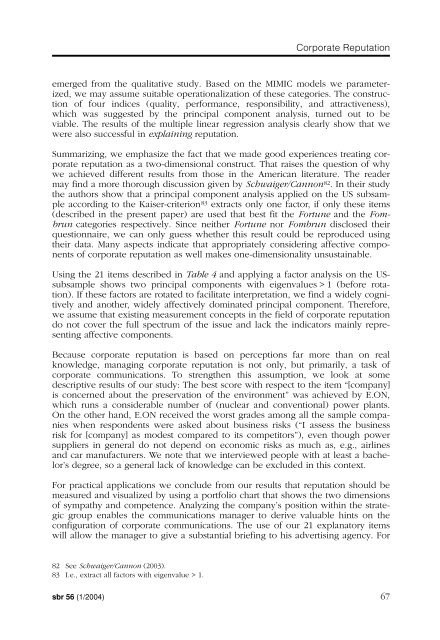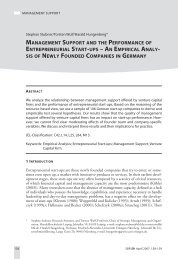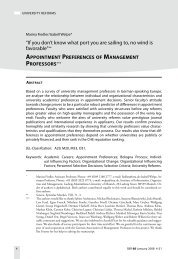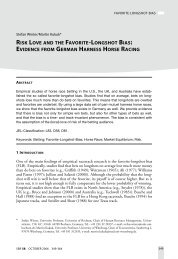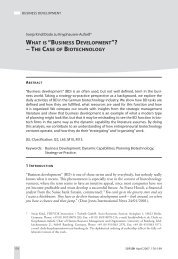components and parameters of corporate reputation - sbr ...
components and parameters of corporate reputation - sbr ...
components and parameters of corporate reputation - sbr ...
You also want an ePaper? Increase the reach of your titles
YUMPU automatically turns print PDFs into web optimized ePapers that Google loves.
Corporate Reputation<br />
emerged from the qualitative study. Based on the MIMIC models we parameterized,<br />
we may assume suitable operationalization <strong>of</strong> these categories. The construction<br />
<strong>of</strong> four indices (quality, performance, responsibility, <strong>and</strong> attractiveness),<br />
which was suggested by the principal component analysis, turned out to be<br />
viable. The results <strong>of</strong> the multiple linear regression analysis clearly show that we<br />
were also successful in explaining <strong>reputation</strong>.<br />
Summarizing, we emphasize the fact that we made good experiences treating <strong>corporate</strong><br />
<strong>reputation</strong> as a two-dimensional construct. That raises the question <strong>of</strong> why<br />
we achieved different results from those in the American literature. The reader<br />
may find a more thorough discussion given by Schwaiger/Cannon 82. In their study<br />
the authors show that a principal component analysis applied on the US subsample<br />
according to the Kaiser-criterion 83 extracts only one factor, if only these items<br />
(described in the present paper) are used that best fit the Fortune <strong>and</strong> the Fombrun<br />
categories respectively. Since neither Fortune nor Fombrun disclosed their<br />
questionnaire, we can only guess whether this result could be reproduced using<br />
their data. Many aspects indicate that appropriately considering affective <strong>components</strong><br />
<strong>of</strong> <strong>corporate</strong> <strong>reputation</strong> as well makes one-dimensionality unsustainable.<br />
Using the 21 items described in Table 4 <strong>and</strong> applying a factor analysis on the USsubsample<br />
shows two principal <strong>components</strong> with eigenvalues > 1 (before rotation).<br />
If these factors are rotated to facilitate interpretation, we find a widely cognitively<br />
<strong>and</strong> another, widely affectively dominated principal component. Therefore,<br />
we assume that existing measurement concepts in the field <strong>of</strong> <strong>corporate</strong> <strong>reputation</strong><br />
do not cover the full spectrum <strong>of</strong> the issue <strong>and</strong> lack the indicators mainly representing<br />
affective <strong>components</strong>.<br />
Because <strong>corporate</strong> <strong>reputation</strong> is based on perceptions far more than on real<br />
knowledge, managing <strong>corporate</strong> <strong>reputation</strong> is not only, but primarily, a task <strong>of</strong><br />
<strong>corporate</strong> communications. To strengthen this assumption, we look at some<br />
descriptive results <strong>of</strong> our study: The best score with respect to the item “[company]<br />
is concerned about the preservation <strong>of</strong> the environment” was achieved by E.ON,<br />
which runs a considerable number <strong>of</strong> (nuclear <strong>and</strong> conventional) power plants.<br />
On the other h<strong>and</strong>, E.ON received the worst grades among all the sample companies<br />
when respondents were asked about business risks (“I assess the business<br />
risk for [company] as modest compared to its competitors”), even though power<br />
suppliers in general do not depend on economic risks as much as, e.g., airlines<br />
<strong>and</strong> car manufacturers. We note that we interviewed people with at least a bachelor’s<br />
degree, so a general lack <strong>of</strong> knowledge can be excluded in this context.<br />
For practical applications we conclude from our results that <strong>reputation</strong> should be<br />
measured <strong>and</strong> visualized by using a portfolio chart that shows the two dimensions<br />
<strong>of</strong> sympathy <strong>and</strong> competence. Analyzing the company’s position within the strategic<br />
group enables the communications manager to derive valuable hints on the<br />
configuration <strong>of</strong> <strong>corporate</strong> communications. The use <strong>of</strong> our 21 explanatory items<br />
will allow the manager to give a substantial briefing to his advertising agency. For<br />
82 See Schwaiger/Cannon (2003).<br />
83 I.e., extract all factors with eigenvalue > 1.<br />
<strong>sbr</strong> 56 (1/2004) 67


